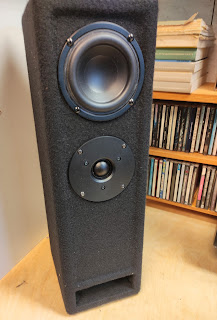Part 2
..on wards..
So now what will we do? Upgrade that filter with audiophile components? Redesign it with what we know now? Or even use some DSP to make an active system?
NON of the above.
Audio reproduction is a construct so if we want to know why that box was so successful in those days we have to thread really careful!
So what I did was replacing those burned resistors with beefier ones of the original value. However, I did get rid of that mystery non working 100nF to make some room. Purists forgive me if you hear a change in the 200kHz region.
I also replaced that electrolytic cap with some MKT I had lying around. We all agree that (old) electrolytics are a pain, right?
They serve as impedance-equalizing for the woofer so not in the 'signal path' anyway.
So how does it sound?
At first I was a bit underwhelmed, so let's look at the measurement to see if I perhaps made a mistake by swapping polarity of one of the components . (note to self, why don't you ever mark down how things where connected?)
No, totally correct. As expected: perfect all-pass behavior. Also the inverted tweeter experiment gives a deep null.
It does sound that way too, like a well balanced loudspeaker. Albeit it bit dull and boring perhaps to much zero-phase-fir-filtering for me lately?
puzzled...
..So let's turn it up and see what happens...
AHA !! Euphonics !! I can do euphonics, after all I have been a live sound engineer for many years. So I need a bigger amp, as I was testing with one of my whimsy yet brilliant sounding gain-clone-single-chip amps.
Unfortunately I don't have some spare Bryston lying around but I do have some class A amp from a prior experiment.
Now stuff starts to be clear why people have blown these speakers into smithereens: they just say more more more more more..
More off what? More of that fantastic low-end! That tweeter I do know: not the best 7kHz I ever did hear, but that transmission line is real fun!
Here you go: measurement very close to the port. You can see the smoothly playing 60Hz (such nice frequency)
But it does look a bit worrisome around 220Hz, right? That's a general problem with transmission lines, maybe I can repair that a bit with some more experimental stuffing
Now will this loudspeaker work as a generic monitor loudspeaker in 2023 ?
We would first have to define what a monitor speaker is.
Contrary to some big names in loudspeaker-design-industry (not studio people), I have the feeling that working as a mixing engineer is also a part of the creational phase. Not re-production as in playing back the end result.
So a studio monitor is not there as a reference of the end result but to make you do your creative part in a stimulating way. And press you to reach further, higher, better, newer.
These monitors came into fashion when we (in live sound) started working with band pass (6th order) subs..and hey: let's try some Portishead / Massive attack and drum 'n bass (Propellerheads!)
...woohaaaaa... this is the shit..damn!
How revealing is that!
Now does recent music like Billie Eilish, Whispering Sons, (modern) classical music work? nah, unless you really enjoy that '90's sauce on everything.
That being said: some of these sound system blokes are experiment a lot with 1/4 wave sub, as if it is something new.. So who knows what will come into fashion again, after all everything seems to go in circles.
And another day of listening + experimenting: Red line is port measurement without any additional stuffing, whitish line is with some extra 'sheep wool' stuffing. Sure: low end is cleaner + sounds more tight with the stuffing but the 'fun' is gone..
More research is required: I will use the extra parts to make a home brew TL and in the meantime get a better (DSP) crossover because the groupdelay of that conventional filter is starting to annoy me. The restored boxes will serve as a reference (in my memory database) to that.
Keep checking!















